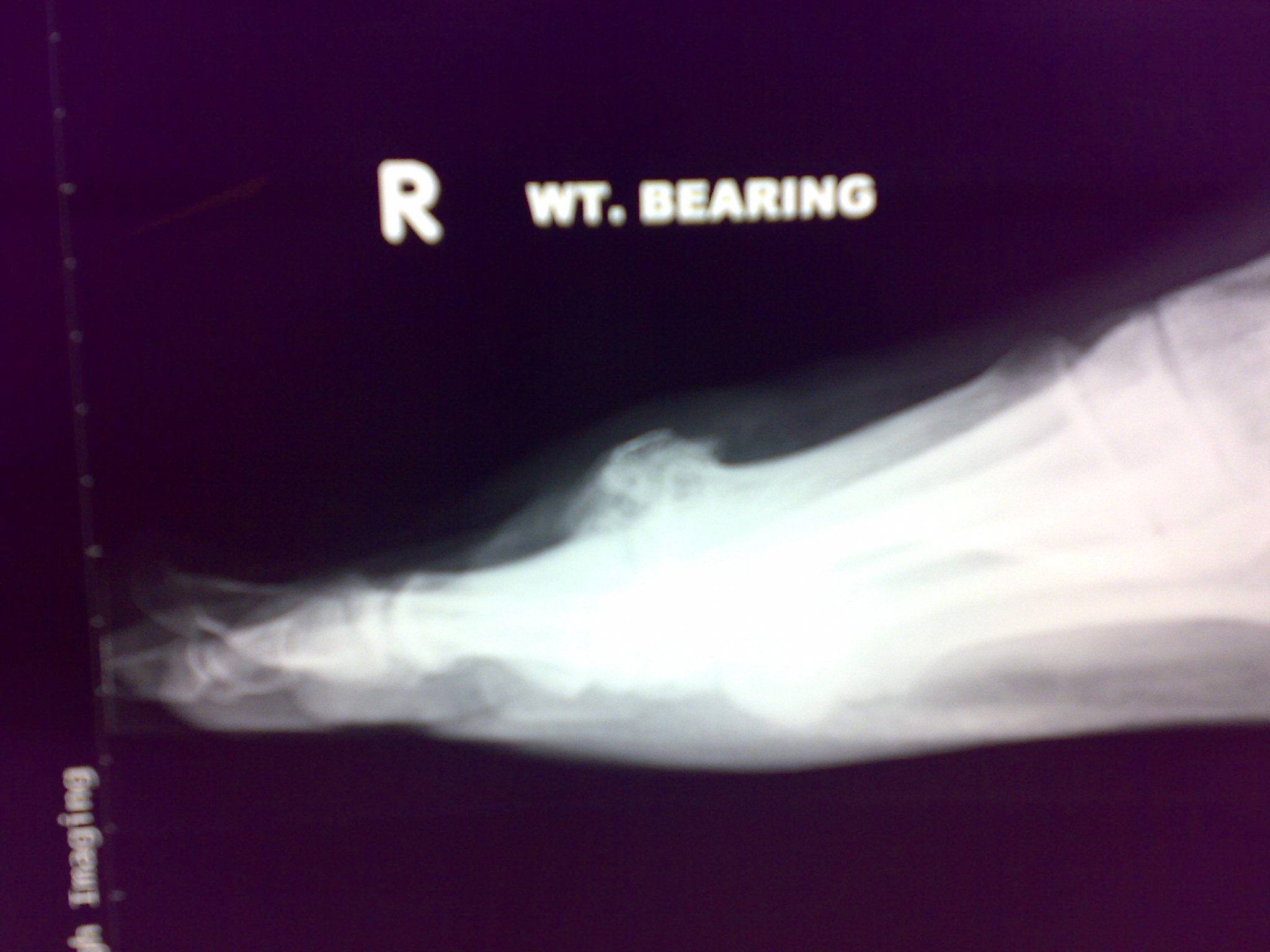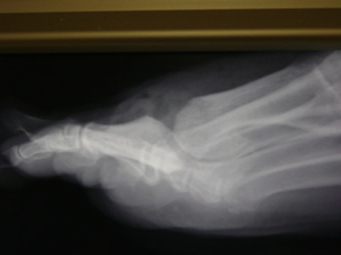Big toe joint arthritis, also called hallux rigidus, is a degenerative condition where the cartilage at the base of the big toe wears down, leading to stiffness, swelling, and pain. It can limit daily activities like walking, running, or wearing shoes comfortably.

What Is Big Toe Joint Arthritis
One of the most common conditions a foot surgeon will see is a painful, stiff big toe joint. There are various names for this condition, and you may see it written as “Hallux Limitus” or “Hallux Rigidus“. The medical name for the big toe is the hallux, and when there is less or limited range of motion, it is called hallux limitus. When stiff and more advanced it is known as hallux rigidus.
What causes painful, stiff big toe joints?
Stiff and painful big toe joints are caused by osteoarthritis or more simply known as arthritis. The arthritis is caused by two main reasons:
- The most common cause is known as post-traumatic. This means the joint has been damaged at some point in the past. The big toe joint is an essential joint; our body weight is pushed off through this joint at every step. As well as being a very important joint, it is also a very easily damaged joint. This damage can be from stubbing the toe, dropping something on the toe, having the toe stood on or a sporting injury where the joint is pushed too far in one position. This trauma can lead to a fracture in the joint or damage to the cartilage. Once the joint is damaged the repetitive motion at the joint will gradually wear the joint away.
- The second reason is often known as abnormal or excess motion. Some activities or lifestyles can simply wear the joint away. Some people walk, run or even dance during the day, leading to tens of thousands of steps, and as each step pushes through this joint, it can wear away.
- There are other less common causes, such as having very flat feet or having one of the bones in the joint excessively long.
What are the signs of big toe joint arthritis?
The signs of a stiff arthritic joint are typically pain, stiffness and enlargement.
- The joint will become painful. Initially, it may only hurt after long episodes of activities; however, this will occur more often and can eventually ache at night.
- The joint will gradually move less and less, leading to problems bending the toe for certain activities such as squatting down or yoga.
- The joint will become more prominent as arthritis progresses. The joint will develop spurs, and these spurs can become enormous, making fitting into shoes a considerable problem.
Why does the big toe joint hurt?
The cartilage wears away with arthritis exposing the raw bone underneath. Raw bone on raw bone is very painful. As arthritis progresses, the body produces spurs. These spurs can become very large, and eventually, the spurs hit each other as the joint moves. These spurs can also dig into the overlying tendons and even nerves. In advanced stages, the spurs will often fracture off as they hit each other, leading to marked and sudden pain.
Why is the big toe joint stiff?
A healthy big toe joint has a rounded structure with robust pearly material (cartilage) at the end of the bones and oily fluid in the joint. This allows the bones to glide over each other and not grind or catch. Once this changes again, the spurs hit each other, the fluid is less oily and the cartilage wears away.
What is the 1st MTP joint?
The MTP joint is the medical abbreviation or acronym for the big toe joint. It is the 1st metatarsophalangeal joint. It is made up of a bone on the big to called a phalanx and bone in the central part of the foot called the 1st metatarsal.
Is this the same as a bunion?
No, it is not. Often it may be wrongly diagnosed as a bunion; however, a bunion is a deviation of this joint and the bump here is form a bone sticking out in the wrong position. In arthritis, the bumps are the spurring that develops. Some bunions can eventually end up with secondary arthritis when they become significant.
How do we diagnose arthritis in the big toe joint?
This is done with a simple X-ray. The X-ray will be assessed, and the spurring, loss of joint space and various other signs are apparent to see. During a consultation, the joint will be evaluated for range of motion, and the presence of spurring will be checked. The joint will often creak or grind as it is moved.
What are the non-surgical treatments?
- In minor cases orthotics can help protect the joint; however, these will not fix or get rid of the arthritis, they simply try to change the way the joint moves to help reduce pain and slow the progression of the damage. These are best to be custom made, and a podiatrist is the person to see for this.
- Steroid/cortisone injections can help with pain in the early stages; however, they will not fix the arthritis, and any relief is typically short. This may be a good idea if you want some temporary relief for a holiday.
- Stem cell injections. These injections may be a solution in the future; however, the technology is not ready yet. If the spurring has already developed and the joint has become enlarged, then this is definitely a waste of money. The stem cell injection will not magically remodel the joint.
- Cartilage transfers. Again, the technology is not there for these joints yet.
- Paracetamol has been proven to be the best medication for arthritis and can be taken the help with the pain. Do remember if you do this, it will not cure or fix anything and always take as instructed and never take more than the advised amount each day.


Big Toe Joint Arthritis Surgery and Recovery
When do I need surgery?
Big toe joint arthritis surgery is typically carried out once the joint becomes painful, begins to damage the rest of the foot, is painful when wearing shoes or is starting to impact on your daily activities.
Big toe arthritis surgery in the past typically involved fusions, was painful and would take a long time to recover.
With modern procedures, this is now not the case, and joint motion can be maintained.
What surgery is available?
- If the arthritis is caught in the very early stages, then a cheilectomy or tidy up can be carried out.
- The most common surgical treatment is to fuse the joint. This will remove the pain; however, the joint will not move and can on occasions, lead to an overload of other joints.
- Joint implants have not proven successful in this joint. Hip and knee replacement surgery work well; however, implant replacements in the big toe joint have not produced the results expected, and for this reason, they are seldom used.
- An ideal procedure would aim is to debulk the joint, remove pain and regain motion. The procedure that allows this is A Capsular Interpositional Arthroplasty.
What is a Capsular Interpositional Arthroplasty?
- This procedure involves a small incision over the painful joint;
- the joint is remodelled by removing all the spurring and returning the joint to its original size and function.
- Since the cartilage has worn away, something needs to be done to protect the ends of the bones.
- Joints have a thin protective capsule around them the holds the oily fluid in place. This becomes very thick in arthritic joints. This thickened joint capsule is released from one of the bones, and a flap of this thickened tissue is stitched or interposed into the joint was to produce a living spacer.
- This should then allow for pain free motion.
- Research has now shown this produces good long-term results.
What is involved in the recovery after capsular interpositional arthroplasty surgery?
The surgery is carried out as a day surgery case, and there is no need for an overnight stay in the hospital. This surgery allows patients to be on their feet immediately following the procedure. In these instances, patients are expected to wear a post-operative protective shoe over their bandaging to protect the surgical site. In the first 3-7 days, patients are expected to rest as much as possible even though they can walk to the toilet or to perhaps make a cup of tea or heat up a meal. At your first post-operative review (approximately seven days following the procedure), the dressing is changed, and at two weeks this large dressing is replaced by a very small dressing following a daily saltwater soak. For most patients, a return to regular footwear occurs at about 3 to 4 weeks following the procedure, although this does vary from patient to patient.
When can I drive after the surgery?
It is typically advised to avoid driving while the large dressing is on and you are in the post-op shoe. This will mean you should avoid driving for about 2-3 weeks. This is often for safety reasons.
Is capsular interpositional arthroplasty surgery painful?
One of the main improvements in foot surgery is the marked reduction in pain. Pain is now controlled.
The incisions are very small, and a lot less damage is done during the operation.
The advancements in medication also allow pain not be an issue at all now. Some patients may require more intervention, however many patients experience no pain after the surgery.
Will the arthritis come back after the surgery?
Research has shown us what works and what does not work. The aim of modern capsular interpositional arthroplasty surgery is to produce permanent results. The aim is to do the surgery once and never again; however, there is always the very slight chance that the arthritis may return. The research has shown that the vast majority get good long-term relief without the need for fusion. I must note that fusion is not the wrong thing to do; I just believe maintaining motion is preferable.
What complications can occur?
Modern foot surgery is very safe, and complications are now rare, although there are certain risks that patients must be made aware of, regardless of the rarity.
The risks of foot surgery are very similar to those risks posed by having other surgery, such as infection, unexpected pain, anaesthetic complications, contractures of the wound and unexpected scarring and deep vein thrombosis.
There are also risks associated with having certain medicines during and after your surgery, such as the possibility of nausea and vomiting.
There are many infrequent complications that can occur; these are very rare; however, they can occur.
Risks associated with surgery are explained to the patient during their pre-operative consultation. You will have every opportunity to ask as many questions as you like during the consultation.
Useful resources:
The Australasian College of Podiatric Surgeons
The American College of Foot and Ankle Surgeons
